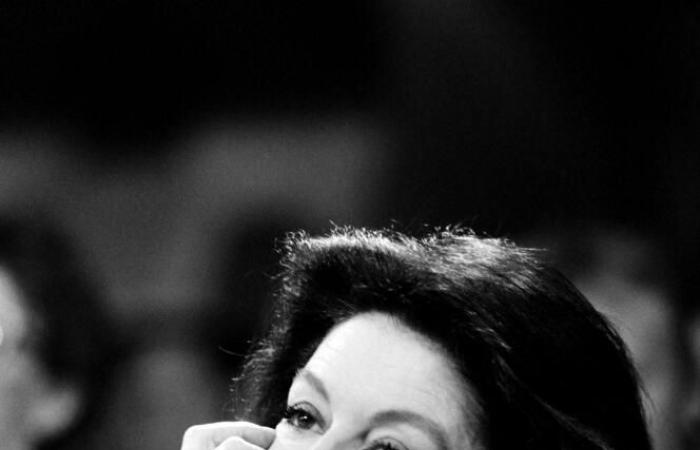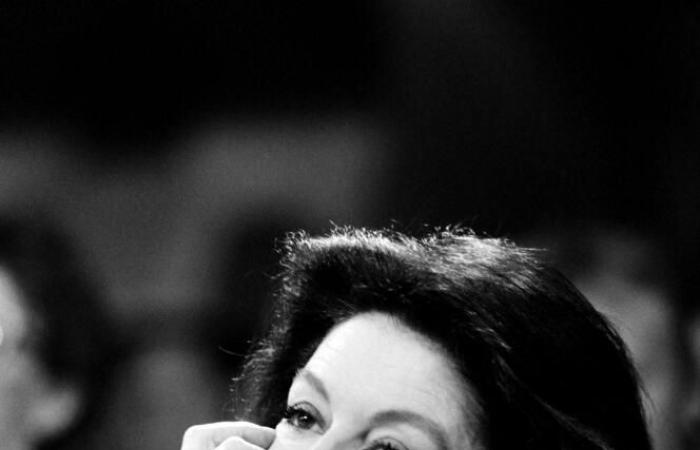Anouk Aimée didn’t like people talking about her age. Met in 2012, on the occasion of the theatrical release of Lolaby Jacques Demy, she had inaugurated the discussion of a request: “Please, let’s not talk about my age. Nobody cares. » What was disturbing was that, saying this, she sounded exactly the same as Lola had fifty-one years earlier. So it was so charming to hear him say in the present tense “Lola, it’s me”, as if time had indeed not mattered. It was a coquetry, no doubt, this ageless present, and the coquetry however said a lot about the lady, and the way she had to lead her boat without much concern for the spray, the opinion or a career, before passing away on Tuesday June 18, at the age of 92. “We are extremely sad to announce the departure of my mother Anouk Aiméewrote his daughter, actress Manuela Papatakis, in a message published on Instagram. I was close to her when she died this morning, at her home in Paris. »
She had started very early, and had not wanted to stop, almost seven years later: the time of a London and marital interlude at the end of the 1960s, with the actor Albert Finney, for whom she had wished to play only one role, that of wife, in real life.
Born Françoise Dreyfus on April 27, 1932, in Paris, Anouk Aimée was the daughter of actors, but said she had nothing of the“ child of the ball.” She had grown like a wildflower away from the spotlight, raised in part by a godfather and godmother, on the farm. At first she only had an interest in cinema so distant that it barely existed. Destiny had to force her hand, putting her in the path of director Henri Calef, who abruptly asked her if she would like to work in cinema. She had never really known where the yes that had bloomed on her lips had come from.
For this first film, The House under the sea (1946), Françoise is 13 years old, and her character is called Anouk. The artist’s first name found with this first step, remains the name: Jacques Prévert offers it to him. The story is known. They met the following year on the set of a film by Marcel Carné, The flower of age, where she plays with Arletty, Serge Reggiani, Martine Carol. The film remains unfinished: we would have edited around twenty minutes of it and shot half, before the production stopped the costs. What remains are the set photographs by Emile Savitry of a ravishing and then very cheeky Anouk, and this name: “Aimée”, “because everyone loved him”, according to Prévert. We do not refuse such baptism.
Invent yourself
During the war, Françoise had already stopped being called Dreyfus to become Françoise Durand and dodge the yellow star. “Anouk Aimée” was no longer a question of survival, but it still obeyed a vital principle: changing one’s name to invent oneself, without it being a question of becoming something else. “I have never done a complete composition. There is always a piece of me in my roles”, she said. One of them, all the same, almost made him forget Anouk in favor of another first name, Lola, that of the heroine of Jacques Demy’s film. “I no longer know where Anouk begins and where Lola begins, where Lola ends and where Anouk ends”she always said, fifty years later.
Read also | Article reserved for our subscribers Cannes Film Festival 2019: Anouk Aimée and Jean-Louis Trintignant make the Croisette melt in a shower of nostalgia
Add to your selections
Released the following year The good life, Lola (1961) had participated as much if not more than Fellini’s film in the cinematic advent of Anouk Aimée, so singular in her nonchalance. When The good life was intoxicated by capturing the silhouette, the angles of the face which had lost its adolescent cheeks, a hand with long fingers curved over a cigarette, Lola celebrated the birth on screen of a body, one of those that cinema would never forget again: a trainer in a basque and fishnet tights, as spared from vulgarity as the naked Venus in her Botticelli hair. Impossible to imagine, and yet Demy had done it. Anouk Aimée had simply trusted, and did not try to explain the miracle. She only observed: “There are people who can do everything. Women who say, “Oh shit, you’re pissing me off.” Some shock, others not. Lola can do it without shocking, be rude without anyone noticing, because there is no vulgarity in her. »
After Demy, Anouk Aimée seemed to carry a piece of Lola in all her other roles, this piece: a sort of state of grace, which allowed her to do and play everything, without ever being touched by filth or mediocrity. . Not that she ever had it in her heart to tempt the devil, but that she almost always played elegant, or that she made elegant out of everyone she played, it was still and always elegance. , even – this is far from being given to everyone – at Jean-Pierre Mocky (The Dredgers, director’s first film, released in 1959).
Also read (2012) | Search for “Lola”, you will find Anouk
Add to your selections
Very quickly, his career took off internationally. At 17, she played alongside Trevor Howard in The Golden Salamander (1950), by the British Ronald Neame, producer of David Lean’s first films. In 1955 and 1956, she can be seen in two German films, Love never dies, do. W. Fischer, and Nina, by Rudolf Jugert. In 1959, she played a small role in The tripan American film by Anatole Litvak, who, six years earlier, had An act of lovefeatures the very young Brigitte Bardot, two years Anouk Aimée’s junior.
Catherine Deneuve, 16, then bides her time: the blonde Bardot, the brunette Aimée embody abroad the two faces of French beauty, which one could not imagine more different. On the one hand, the baby doll in a bikini, the wild hair nourished by the sun, the curves. On the other, the mysterious halo of dark hair, alabaster skin, the line, with this single and astonishing Hollywood feature of heavy eyelids under the large black line, à la Monroe.
On screens around the world
If Bardot’s international aura owes little to her rare cinematographic collaborations outside France, Anouk Aimée shines more sustainably on screens around the world, where she finds some major roles. Less, no doubt, than those that his absolute accuracy of play, his fine mastery of contained emotion deserved. Let us quote, unsurprisingly, Fellini: the upper-class woman exhausted by the boredom of The good life, the deceived and smiling wife of Eight and a half. Later, Bellocchio, for which she played the depressive Marta inhabited by dizziness, which earned her the prize for best actress at the Cannes Film Festival in 1980 for The leap into the void.
The United States also courted her, displaying more unexpected attractions and finery (in 1962, she played a peplum queen for Robert Aldrich and Sergio Leone in Sodom and Gomorrah) or directly inspired by her aura as a fashion icon, when she plays a model in The appointment, by Sidney Lumet, in 1969. She was 37 years old when this film was released, and the character well sums up her singular status in the cinematic landscape: the mysterious Carla, officially a model, is suspected by her jealous fiancé or husband of prostituting herself. .
On the one hand, the icon, the untouchable, the one who seems to exist only on the glossy paper of elegant magazines. On the other, the public body, purchasable, disposable. Two contradictory, or perhaps complementary, fantasies which continue to shape the epinal image that we often have of the beautiful French woman in America.
Bardot was already “there” woman in And God created the woman (1956), when ten years later Anouk Aimée became “one” wife for Claude Lelouch, in A man and a woman (1966): a woman, any woman (the stranger that Lelouch meets on a beach, and who inspires the film), and ultimately the one that we will never forget again – in the romance that the film tells, and from his chair as an enchanted spectator.
Anne Gauthier (her name hardly matters), film technician, heroine of the simplest story and one of the most beautiful love films in the world. It won hearts all over the world, garnering awards, the Oscar and the Golden Globe for best foreign language film, the Golden Globe for best actress for Anouk Aimée. This story in the form of a hymn to love, which was nevertheless intended for Romy Schneider, seems tailor-made for the great lover that Anouk Aimée was then and will be.
She married three times, with the Greek filmmaker Nico Papatakis at 19, the musician Pierre Barouh, met on the set ofA man and a woman, of which he was the author and performer of the famous refrain in “chabadabada”, the English actor Albert Finney. Lived with Elie Chouraqui, had an affair with Omar Sharif, his partner in The appointment – so many pages of her life that she constantly kept under a veil of mystery, although she never refrained from talking about them.
The taste of secrecy
The most eloquent evocation she was able to make of it did not use her words, but those of the American playwright Albert Ramsdell Gurney, with whom she – who was not a regular on the stage – played tirelessly in the theater, between 1990 and 2014, the Love Letters, with Bruno Cremer, then Jean-Louis Trintignant, Philippe Noiret, Jacques Weber, Alain Delon, Gérard Depardieu…
Anouk Aimée loved to talk, but she despised words that reveal, decipher, deflower. She was not a woman to give recipes. Asked about the immense success ofA man and a womanof which she was asked if she had anticipated it, she replied, at 80 years old, with adolescent candor: “We never know these things, but we are happy. It’s a good sign, I think. »
Also read (2022) | Jean-Louis Trintignant, the actor who wanted to remain underground, is dead
Add to your selections
On this occasion, as she had always done, she moved forward in the interview against any analysis or exegesis, which did not seem to have the slightest appeal in her eyes. Gossip had even less, yet no more, on the other side of the coin, than political correctness or wooden language. Only, she responded to each question with a formula which had the grammatical form of an answer, and in what she said tripled, sometimes maliciously, the question marks.
Was this a sign of a taste for this true role of a mystery woman, “a” woman, who could be any woman and yet remains the woman we never forget? More simply, beyond any role, a taste for secrets, and all these things that are all the more beautiful because they are not explained? Perhaps, even more simply, the secret of this unparalleled and enduring elegance, which made her such a singular presence, peaceful in her naturalness, and yet finding in her very transparency the impossible material of her mystery.
Anouk Aimée in a few dates
April 27, 1932 Birth in Paris
1946 “The House Under the Sea”
1960 ” The good life “
1961 “Lola”
1966 ” A man and a woman “
1990 “Love Letters” (theater)
2003 “The Little Birch Meadow”
June 18, 2024 Death in Paris







